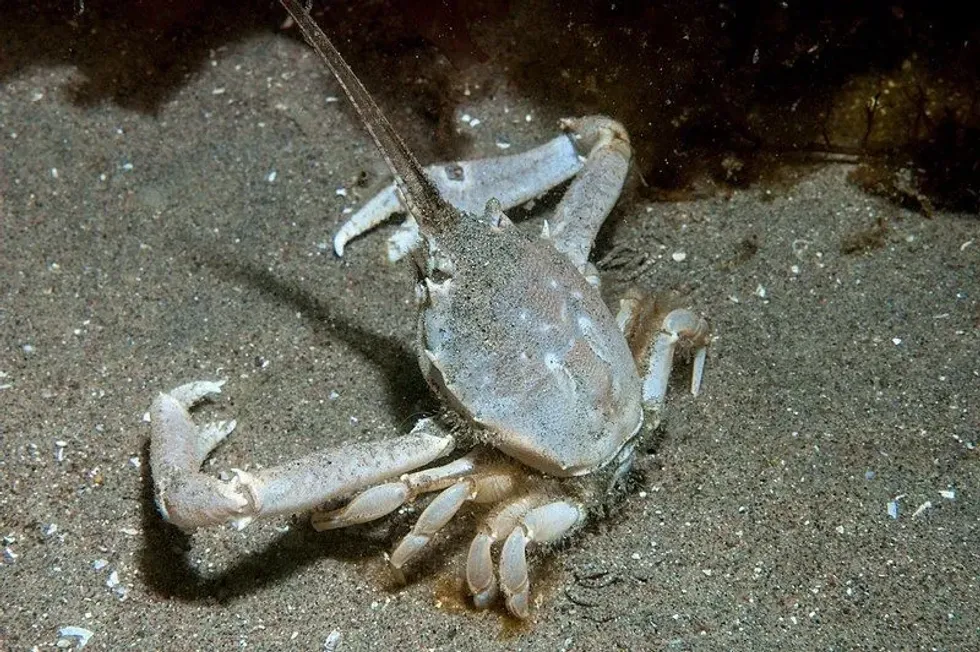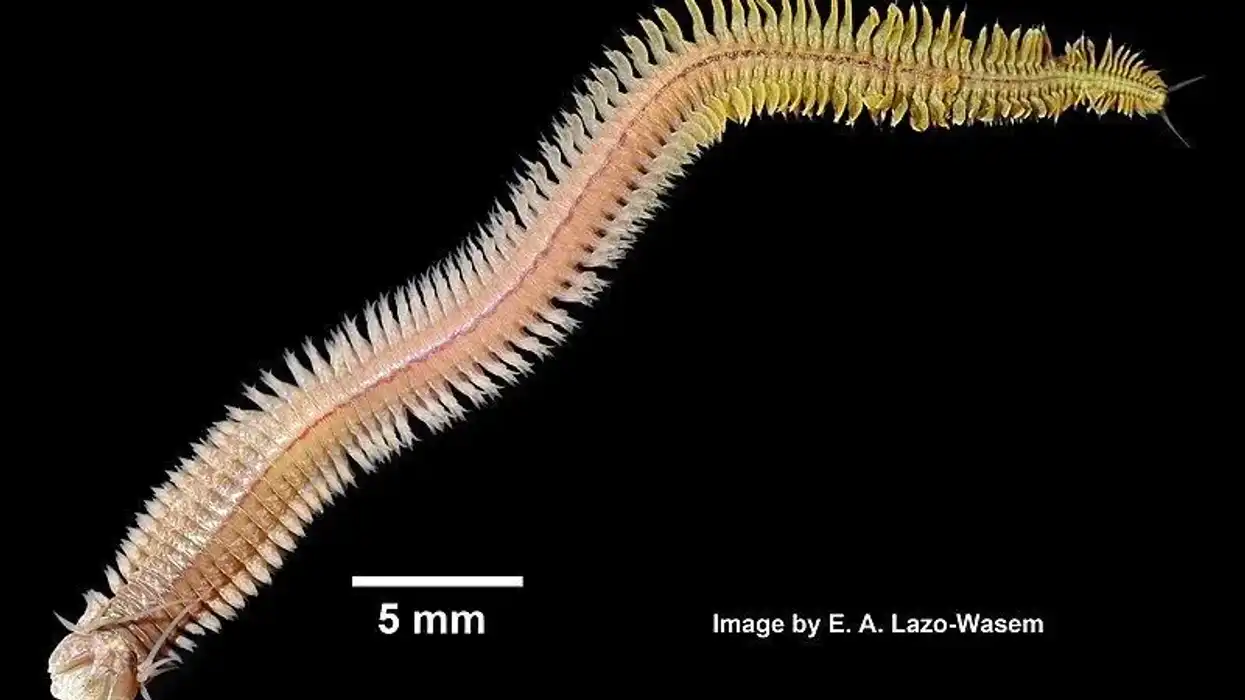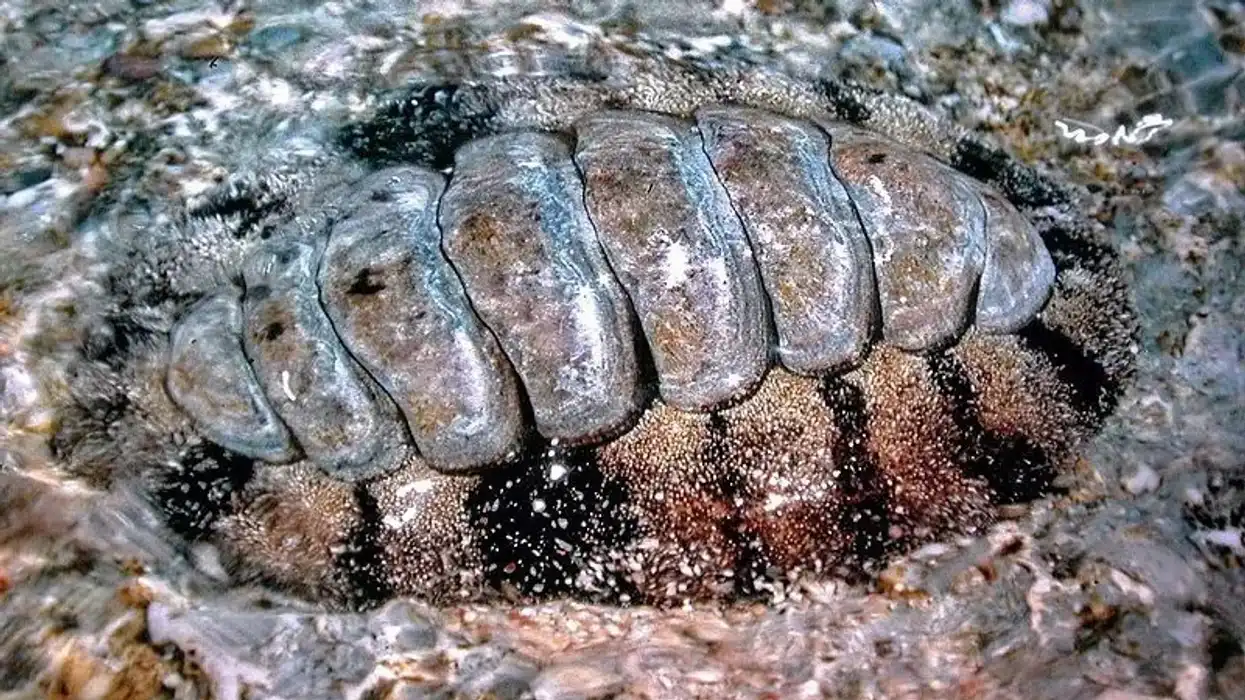The masked crabs, scientific name Corystes cassivelaunus, are well-known sand burrowing crabs and keeps themselves buried under sand burrows. They are native to the North Atlantic, North Sea, Portugal, Norway, and the Mediterranean Sea. They are called the masked crabs because they have a patterned carapace that almost resembles the features of a human face.
This species was first described by the Welsh naturalist Thomas Pennant in 1777. The masked crab habitat is such that they live in sand burrows, low shore coastlines, and low tide surfaces.
They are often washed away on the sandy beaches and many can be seen either dead or alive in burrows. They feed on bivalves, worms, small crustaceans, and small invertebrates like snails and centipedes.
They have a pair of sharp tube-like antennae that are used for breathing oxygenated water and for forging buried food. These species are sexually dimorphic because the claws of the male masked crab are much bigger than their carapace, whereas, the female masked crab claws are equal to their shell-like carapace.
They are the only species in the genus Corystes.
If you enjoy reading this article, then do learn some interesting facts about other animals such as the blue crab and the horseshoe crab.
Masked Crab Interesting Facts
What type of animal is a masked crab?
The masked crab, Corystes cassivelaunus, is also called the helmet crab and the sand crab. They are famous for their pair of antennae between their eyes and carapace, which almost features a human face.
What class of animal does a masked crab belong to?
The masked crab, Corystes cassivelaunus, belongs to the class of Malacostraca and the genus Corystes. They are the only species in this genus. They are from the family Corystidae and the order Decapoda.
How many masked crabs are there in the world?
The exact number of these masked crab species is not counted and is unknown globally.
Where does a masked crab live?
The masked crab, Corystes cassivelaunus, does not have a wide geographical range. They are mostly found near the North Atlantic, North Sea, from Portugal to Norway, and the western British Isles. They are even spotted near the Mediterranean Sea.
What is a masked crab's habitat?
The masked crab's habitat is almost like any other crab in sand burrows, low tide areas, and low shore coastlines. They are often washed away to the shores by strong high tides and storms.
These natural calamities often make them go from one seaside to the other, such as from Portugal to Norway and the British Isles.
They can be commonly seen buried in sandy areas in burrows. During storms or high tides, they are seen under burrows covered with sand where they can protect themselves from being washed away by the tides.
Who do masked crabs live with?
Generally, these sand crab species are seen in isolation, but they are seen in large groups when they are washed away by storms or high tides to seashores. Mostly, adults are solitary, and young zoea larvae are found in groups.
How long does a masked crab live?
The exact age of these masked crabs has not been estimated, but with general facts about crabs, it is evident that they live up to two to three years of age.
How do they reproduce?
The masked crab, Corystes cassivelaunus, reproduction behavior is very unique and features differently from most crabs. The males try to lure the females by using their smell and touch sensors.
It takes a long time to mate indirectly because the sperm are released by the male in a particular place and if the female gets convinced by the male partner, then she makes contact with those sperm released.
The eggs are carried underneath the body of the females for almost a time period of 10 months.
The eggs are released in clutches and in a similar manner, and every clutch size varies. As these species are subtropical freshwater species, the breeding of such species mostly takes place around the summer season.
What is their conservation status?
The conservation status of these pointed tube antennae sand crab species has not been evaluated and is unknown globally.
Masked Crab Fun Facts
What do masked crabs look like?
The masked crab, Corystes cassivelaunus, is commonly known as the masked crab because its carapace features a human face. The pattern of their shell carapace is the most notable point.
They have an edged tube. The color varies from red to brown, cream to yellow.
Some of the time, the base is white in color. These species have a sharp tube-like pair of antennae which are used for the flow of oxygenated water into their bodies and even for the buried food which they forge on the sandy beaches and seashore coastlines.
Many times, this appears to be joined together, but it is not so.
The length of these antennae is bigger than their carapace and they are placed between their two eyes. They are sexually dimorphic and the male can be easily identified from the female.
The female claws are much smaller than the males. The male has large claws longer than their carapace, whereas, the female's claws are equal to the carapace.

How cute are they?
These sand crab species are not cute. They look wild, although they are small in size. Their pincers or claws make them more dangerous and this species is far from the list of their cuteness.
How do they communicate?
These species are often seen using olfactory and tactile cues. When males have to mate with female counterparts, they represent precopulatory courtship.
How big is a masked crab?
The masked crab, Corystes cassivelaunus, may grow 2-3 in (5-7.8 cm) longer in size. Their size varies and the length of their carapace is 1.6 in (4 cm) long. The males are larger than the females.
How big do masked crabs get?
They may grow to a maximum size of 3 in (7.8 cm). In rare cases, they may grow up to the size of 4 in (10 cm).
How much does a masked crab weigh?
The masked crab, Corystes cassivelaunus, is 0.5-0.6 oz (15-19 g)
What are the male and female names of the species?
There are no specific names given to the male and female species. They are commonly known as the male masked crab and the female masked crab.
What would you call a baby masked crab?
The babies of these human-faced carapace crab species are called zoea.
What do they eat?
These brown burrowing sand crabs generally form a very reserved sort of carnivore diet, especially using their sharp tube-like long antennae. They feed on food like small crustaceans like krill, brittle stars, invertebrates like snails, worms, little serpent stars, and bivalves.
Are they dangerous?
There is not much evidence available in the context of their danger to humans, but as they have larger claws which might be a cause for concern. If they are aggressive in their behavior, which is unknown globally, they will, of course, pinch humans with their claws, which might be painful.
Would they make a good pet?
Yes, these human-faced carapace species would make good pets, but ideally, it would not be a good idea to keep them in captivity due to their natural habitation in sand burrows and buried under them.
Did you know...
They can go deep into water at a depth of 0.33 ft (10 cm) deep.
They are known to swim against the water, dragging their forelimbs in a forward direction. They swim in a similar manner to humans. They swim as if they are dragging.
The deposits of calcium phosphate have been reported in their bone tissues.
The robber crab, Birgus latro, is known to steal shiny objects such as silverware and pots. These species are commonly called the coconut crab.
Naming the masked crab
They are called masked crabs because they have a human face-like pattern on their carapace and they are also known as helmet crab and sand crab.
How does a masked crab camouflage itself?
The color of their bodies is so similar to the color of sand that they well camouflage themselves in their natural surroundings.
Here at Kidadl, we have carefully created lots of interesting family-friendly animal facts for everyone to discover! Learn more about some other arthropods from our king crab interesting facts and hermit crab fun facts for kids.
You can even occupy yourself at home by coloring in one of our free printable crab coloring pages.










